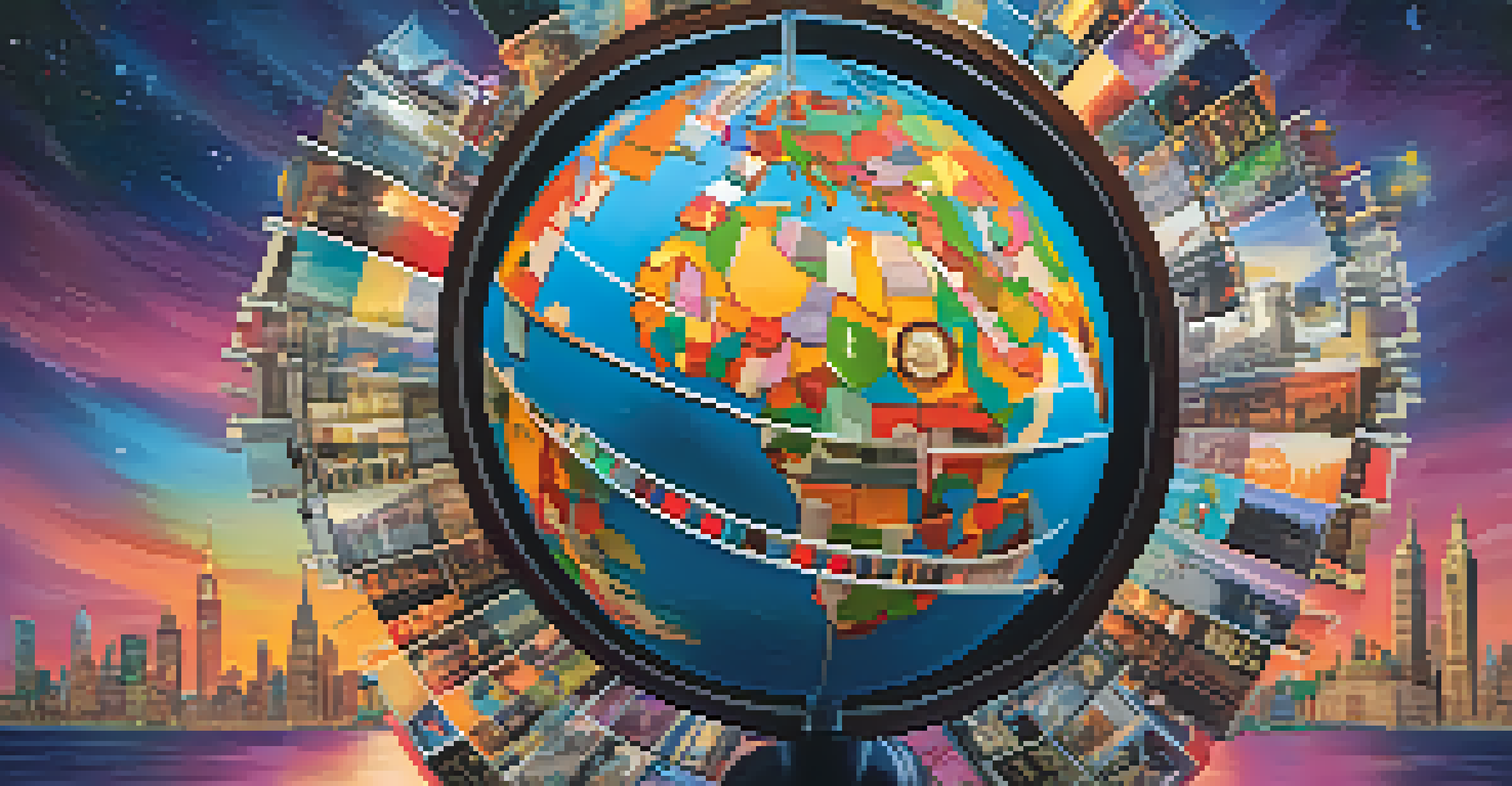The Global Reach of Streaming Services: A Cultural Analysis

The Rise of Streaming Services in Global Entertainment
Streaming services have revolutionized how we consume media, offering instant access to a vast array of content. Platforms like Netflix, Amazon Prime, and Disney+ have expanded their reach beyond borders, allowing viewers from various cultures to explore diverse narratives. This accessibility has not only changed viewing habits but also how stories are told, catering to global audiences while maintaining local flavors.
The world is a book, and those who do not travel read only one page.
As these services grow, they invest in original content that reflects the unique cultures of different regions, such as Netflix's commitment to producing Korean dramas or Bollywood films. By showcasing local talent and storytelling techniques, streaming platforms help amplify voices that might not have received attention otherwise. This shift is crucial in breaking down stereotypes and fostering a more nuanced understanding of global cultures.
Moreover, the rise of streaming has led to increased competition, prompting traditional media outlets to adapt or innovate. As a result, we see a blend of cinematic styles and storytelling methods, enriching the global entertainment landscape. The phenomenon of binge-watching has also emerged, changing our relationship with content consumption and encouraging deeper engagement with diverse cultural narratives.
Cultural Exchange: The Power of Diverse Storytelling
One of the most exciting aspects of streaming services is their role in cultural exchange. By providing a platform for content from around the world, these services allow audiences to experience stories that reflect different lifestyles, beliefs, and traditions. This exposure fosters empathy and understanding, bridging gaps between cultures in a way that traditional media often struggles to achieve.

For instance, shows like 'Money Heist' from Spain or 'Squid Game' from South Korea have not only gained popularity in their home countries but have also resonated with audiences globally. These series provide insights into societal issues, while their unique storytelling techniques captivate viewers, making cultural differences feel more relatable. Through this exchange, viewers develop a broader worldview, appreciating the richness of human experiences.
Streaming Services Transform Media
Streaming platforms like Netflix and Disney+ have reshaped how audiences access and engage with diverse cultural narratives.
However, it's important to consider the potential for cultural homogenization. While streaming services promote diversity, they can also lead to the dilution of local cultures if global trends overshadow indigenous stories. Striking a balance between showcasing diverse narratives and preserving cultural authenticity is essential to sustaining this newfound cultural exchange.
Impact on Local Film and Television Industries
Streaming services have had a profound impact on local film and television industries, often acting as both a challenge and an opportunity. While they can draw audiences away from traditional media, they also provide local creators with new avenues for global exposure. Many filmmakers and showrunners now produce content specifically for these platforms, catering to a wider audience than ever before.
Diversity is the one true thing we all have in common. Celebrate it every day.
This shift has led to an influx of investment in local productions. Streaming platforms often allocate substantial budgets for original content, elevating the quality of local films and series. For example, Netflix's investment in Indian cinema has resulted in a surge of high-quality productions that blend traditional storytelling with modern themes, appealing to both national and international viewers.
Moreover, the presence of global streaming services encourages collaboration between local and international creators. By working together, they can share resources, knowledge, and creative insights, enriching the overall quality of content. This collaborative spirit not only enhances local industries but also helps create a more interconnected global entertainment ecosystem.
Shaping Viewer Preferences and Consumption Patterns
The rise of streaming services has significantly influenced viewer preferences and consumption patterns. With the ability to watch content on-demand, audiences now prioritize convenience and personalization over traditional schedules. This shift has given viewers the power to curate their own viewing experiences, leading to an explosion of niche genres and diverse programming options.
As a result, viewers are increasingly drawn to content that resonates with their identities and interests. Streaming platforms utilize algorithms to recommend shows and movies tailored to individual tastes, creating a more engaging experience. This personalization not only enhances viewer satisfaction but also encourages exploration of genres and cultures that might have been overlooked in traditional media.
Cultural Exchange Through Storytelling
These services facilitate cultural exchange by showcasing global content, allowing viewers to connect with different lifestyles and traditions.
However, this shift also raises questions about content saturation and the potential for echo chambers, where users are only exposed to viewpoints that mirror their own. It's crucial for streaming services to ensure a balance between personalized recommendations and diverse content offerings, allowing audiences to discover new perspectives while still enjoying their favorites.
The Role of Language and Subtitles in Global Streaming
Language plays a pivotal role in the global reach of streaming services, and the availability of subtitles and dubbing has made content more accessible to international audiences. This inclusion allows viewers to enjoy shows and films in their original language, preserving the authenticity of the storytelling while still reaching a broader audience. Subtitles can enhance the viewing experience, enabling viewers to connect more deeply with the characters and emotions portrayed.
Streaming platforms have invested in high-quality translations and adaptations, recognizing that language barriers can limit audience engagement. With shows like 'Narcos' and 'Dark,' the original language often adds to the cultural richness, allowing viewers to immerse themselves in the setting and context. By embracing multiple languages, these services not only cater to diverse audiences but also promote linguistic diversity.
However, this approach also presents challenges. While subtitles and dubbing are essential for accessibility, they can sometimes lead to misunderstandings or loss of nuance in translation. As streaming services continue to expand globally, finding the right balance between accessibility and authenticity will be crucial for maintaining the integrity of diverse narratives.
Challenges of Cultural Representation in Streaming Content
Despite the strides made in cultural representation, streaming services still face challenges in accurately portraying diverse communities. Content created for global audiences can sometimes miss the mark, leading to stereotypes or oversimplifications of complex cultures. This misrepresentation can alienate viewers and perpetuate misconceptions, emphasizing the need for authentic storytelling that resonates with local communities.
Moreover, the pressure to produce content that appeals to a global market can lead creators to prioritize entertainment value over cultural accuracy. This dilemma raises questions about the responsibilities of streaming platforms in promoting genuine representation. Engaging local voices in the creative process is essential to ensure that stories reflect the true diversity and richness of cultures.
Authenticity in Cultural Representation
Despite advancements, streaming services must prioritize authentic storytelling to avoid stereotypes and ensure genuine representation of diverse communities.
To address these challenges, streaming services must prioritize inclusivity and authenticity in their content development. By collaborating with local creators and communities, they can foster a deeper understanding of cultural nuances. This commitment to genuine representation not only enriches the viewing experience but also strengthens the bond between content creators and their audiences.
Future Trends in the Global Streaming Landscape
As streaming services continue to evolve, several trends are shaping the future of global entertainment. One significant trend is the rise of interactive content, where viewers can influence the storyline or make choices that impact the narrative. This shift towards viewer participation creates a more immersive experience and could redefine how stories are told across cultures.
Additionally, the integration of augmented reality (AR) and virtual reality (VR) into streaming platforms is on the horizon. These technologies promise to enhance storytelling by allowing audiences to engage with content in new ways, further breaking down cultural barriers. As these innovations develop, they may lead to a more interconnected global community, united through shared experiences.

Lastly, as competition intensifies among streaming platforms, there will likely be a push for greater investment in diverse content. Audiences are increasingly seeking representation, and platforms that prioritize inclusive storytelling will stand out in the crowded market. The future of streaming may very well hinge on the ability to authentically reflect the rich tapestry of global cultures, paving the way for a more inclusive media landscape.